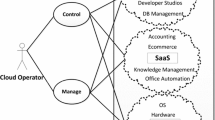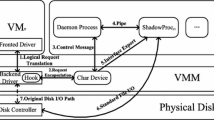Abstract
With the exception of solid state drive, the network I/O generally increases at a faster pace than the I/O capacity of hard disk drive. If the gap between the disk I/O and the network I/O continues to grow, current technologies that are tuned to current state may not be the optimal choices anymore. One of such technologies may be virtual machine migration (VMM). VMM is one of the most frequently mentioned operations in datacenters. One of the purposes of VMM is to ensure the data used by the virtual machine (VM) and the VM using the data are close to each other. However, if the VMMs require longer period of freeze time, VMM under certain situations may be unnecessary. In this paper, a series of simulations are carried out to show that VMM of some cases may not be necessary with enhanced network capacity.








Similar content being viewed by others
Notes
It may be larger under some particular circumstances.
In other words, migration among non-identical machines require much more complicated procedures.
“Dirtying” indicates memory changing, which contaminates already-sent information.
Acknowledgement refers to the reply to a packet to inform the sender that the receiver has properly received the packet.
\(\mu \) of intermediate nodes needs to be greater than or equal to that of the source node.
Source: Top of rack—Destination.
When \(n = 2\), it is binary. When \(n = 16\), it is hexadecimal, and etc.
In BCube, a switch and a server is occupied for each added hop. Therefore, the number of hops in a technical sense is twice what we have calculated.
References
Clark, C., Fraser, K., Hand, S., Hansen, J. G., Jul, E., Limpach, C., Pratt, I., & Warfield, A. (2005). Live migration of virtual machines. In Proceedings of the 2nd conference on Symposium on Networked Systems Design & Implementation, (vol. 2, pp. 273–286). USENIX Association.
Martinez, H. (2009). How much does downtime really cost? InfoManagement Direct, August, 6.
Vmware vsphere vmition: 5.4 times faster than hyper-v live migration. A Principled Technologies Test Report, October 2011.
Agarwal, V., Hrishikesh, M. S., Keckler, S. W., & Burger, D. (2000). Clock rate versus IPC: The end of the road for conventional microarchitectures (vol. 28). ACM.
Shribman, A., & Hudzia, B. (2013). Pre-copy and post-copy vm live migration for memory intensive applications. In Euro-Par 2012: Parallel processing workshops (pp. 539–547). Springer.
Chisnall, D. (2007). The definitive guide to the xen hypervisor. New York: Pearson Education.
Salfner, F., Tröger, P., & Polze, A. (2011). Downtime analysis of virtual machine live migration. In DEPEND 2011, The Fourth International Conference on Dependability, (pp. 100–105).
Nelson, M., Lim, B.-H., Hutchins, G., et al. (2005). Fast transparent migration for virtual machines. In USENIX Annual technical conference, general track (pp. 391–394).
Liu, H., Jin, H., Liao, X., Hu, L., & Yu, C. (2009). Live migration of virtual machine based on full system trace and replay. In Proceedings of the 18th ACM international symposium on high performance distributed computing, (pp. 101–110). ACM.
Hines, M. R., & Gopalan, K. (2009). Post-copy based live virtual machine migration using adaptive pre-paging and dynamic self-ballooning. In Proceedings of the 2009 ACM SIGPLAN/SIGOPS international conference on virtual execution environments, (pp. 51–60). ACM.
Jin, H., Deng, L., Wu, S., Shi, X., & Pan, X. (2009). Live virtual machine migration with adaptive, memory compression. In IEEE international conference on cluster computing and workshops, 2009. CLUSTER’09, (pp. 1–10). IEEE.
Alizadeh, M., Kabbani, A., Edsall, T., Prabhakar, B., Vahdat, A., & Yasuda, M. (2012). Less is more: Trading a little bandwidth for ultra-low latency in the data center. In Proceedings of the 9th USENIX conference on networked systems design and implementation, (pp. 19–19). USENIX Association.
Vasudevan, V., Phanishayee, A., Shah, H., Krevat, E., Andersen, D. G., Ganger, G. R., Gibson, G. A., & Mueller, B. (2009). Safe and effective fine-grained tcp retransmissions for datacenter communication. In ACM SIGCOMM computer communication review (vol. 39, pp. 303–314). ACM.
Alizadeh, M., Kabbani, A., Edsall, T., Prabhakar, B., Vahdat, A., & Yasuda, M. (2012). Less is more: Trading a little bandwidth for ultra-low latency in the data center. In Proceedings of NSDI
Paxson, V., & Floyd, S. (1995). Wide area traffic: The failure of poisson modeling. IEEE/ACM Transactions on Networking (ToN), 3(3), 226–244.
Benson, T., Anand, A., Akella, A., & Zhang, M. (2010). Understanding data center traffic characteristics. ACM SIGCOMM Computer Communication Review, 40(1), 92–99.
Greenberg, A., Hamilton, J. R., Jain, N., Kandula, S., Kim, C., Lahiri, P., Maltz, D. A., Patel, P., & Sengupta, S. (2009). Vl2: A scalable and flexible data center network. In ACM SIGCOMM computer communication review, (vol. 39, pp. 51–62). ACM.
Guo, C., Lu, G., Li, D., Wu, H., Zhang, X., Shi, Y., et al. (2009). Bcube: A high performance, server-centric network architecture for modular data centers. ACM SIGCOMM Computer Communication Review, 39(4), 63–74.
Akoush, S., Sohan, R., Rice, A., Moore, A. W., & Hopper, A. (2010). Predicting the performance of virtual machine migration. In 2010 IEEE international symposium on modeling, analysis & simulation of computer and telecommunication systems (MASCOTS), (pp. 37–46). IEEE.
Clark, C., Fraser, K., Hand, S., Hansen, J. G., Jul, E., Limpach, C., Pratt, I., & Warfield, A. (2005). Live migration of virtual machines. In Proceedings of the 2nd conference on symposium on networked systems design & implementation (vol. 2, pp 273–286). USENIX Association.
Acknowledgments
This research was supported by Basic Science Research Program through the National Research Foundation of Korea (NRF) funded by the Ministry of Education (NRF-2013R1A1A2010388).
Author information
Authors and Affiliations
Corresponding author
Rights and permissions
About this article
Cite this article
Jung, J., Kim, K. & Kim, H. On the Necessity of VM Migration: Simulation on Datacenter Network Resources. Wireless Pers Commun 86, 1797–1812 (2016). https://doi.org/10.1007/s11277-015-3105-8
Published:
Issue Date:
DOI: https://doi.org/10.1007/s11277-015-3105-8




